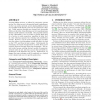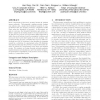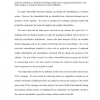80 search results - page 15 / 16 » Attacking and fixing PKCS |
CCS
2006
ACM
13 years 9 months ago
2006
ACM
Location-hidden services, as offered by anonymity systems such as Tor, allow servers to be operated under a pseudonym. As Tor is an overlay network, servers hosting hidden service...
IANDC
2008
13 years 5 months ago
2008
A multi-party contract signing protocol allows a set of participants to exchange messages with each other with a view to arriving in a state in which each of them has a pre-agreed...
MOBIHOC
2005
ACM
14 years 5 months ago
2005
ACM
Node compromise poses severe security threats in wireless sensor networks. Unfortunately, existing security designs can address only a small, fixed threshold number of compromised...
ICST
2009
IEEE
14 years 12 days ago
2009
IEEE
GEGICK, MICHAEL CHARLES. Predicting Attack-prone Components with Source Code Static Analyzers. (Under the direction of Laurie Williams). No single vulnerability detection techniqu...
CCS
2008
ACM
13 years 7 months ago
2008
ACM
This paper reconsiders the threat posed by Shacham's "return-oriented programming" -- a technique by which WX-style hardware protections are evaded via carefully cr...



